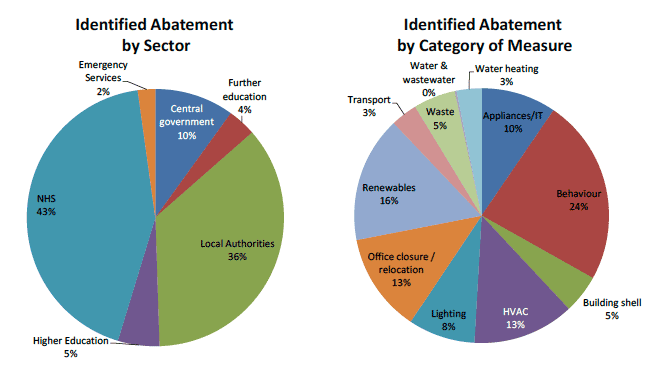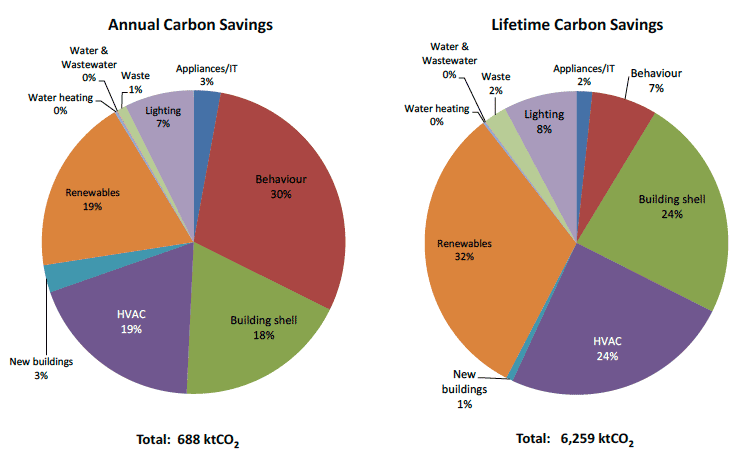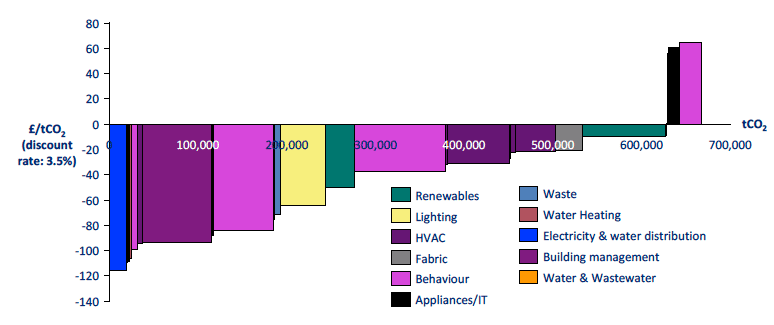Potential carbon abatement from the Scottish public sector: summary report
As part of the RPP2 process, we commissioned the Carbon Trust to estimate the carbon abatement potential of the Scottish public sector to 2030.
4 Estimation of Abatement Potential
Introduction
The primary objective of this study was to estimate the potential for carbon abatement from the Scottish public sector estate, to provide inputs to the RPP2 process and to highlight major areas of opportunity for public sector carbon reduction. As with the baseline calculation it was necessary to distinguish between the overall 'Combined' opportunity including all sources (and the measures that reduce emissions), and the ' RPP2' baseline and relevant measures, excluding traded emissions and transport and waste.
We used two different methods to estimate the abatement potential, one based on information contained in the Carbon Management Plans and one based on the Carbon Trust's proprietary database of carbon reduction recommendations, 'Close Out'. The remainder of this section explains the approach used in each method and summarises the results.
Carbon Management Plan method
Overview
The first method used information in the Carbon Management Plans of the 138 PSBs. As organisations go through the Carbon Management process, they identify a wide range of carbon reduction projects which can be implemented to reach (and exceed) their carbon reduction targets. In most cases the carbon reduction impact in tonnes of CO 2 and the cost of the project are quantified. We were able to extract lists of projects from 67 of the CMPs (many plans were in formats that prevented this) and analyse these in Excel. The 67 plans accounted for around 50% of the Combined emissions baseline.
Identified Reduction Projects
The project information extracted provided a database of c.1,350 carbon reduction projects amounting to c. 250 ktCO 2. Figure 3 shows the breakdown of these projects by sector and category of measure.
Figure 3: Identified Abatement (Combined)

Source: Carbon Trust analysis of 67 Carbon Management Plans
NHS and Local Authorities between them accounted for around 80% of the carbon abatement identified (they accounted for half of the 67 plans analysed and typically have higher average emissions per organisation). Behaviour Change was the single largest category of abatement measure. This is to be expected because the Carbon Management Plan process targets behaviour change projects in particular, because they are a low-cost and impactful intervention.
Estimation approach
In order to estimate the abatement potential of the public sector, we assumed that within each sector ( e.g. NHS, Higher Education), all organisations could implement all the measures identified by the organisations from that sector where we were able to extract and analyse project level information, and that they would achieve the same reduction vs their baseline from that area of activity. So for example, in the Higher Education CMPs analysed, 11 boiler replacement or upgrade projects were identified within the HVAC category, with an average reduction vs baseline emissions of 1.3%.
In this case we would assume that all Higher Education organisations can achieve a 1.3% reduction from boiler upgrades. Using the same approach with other HVAC projects gives a total reduction from HVAC measures (2.9%) which is applied across the whole Higher Education sector baseline. This was repeated for each category and sector to produce a total estimate of abatement potential. The results are shown in Figure 4 below.
In order to produce an estimate that was useful for the RPP2 process, traded measures and transport and waste needed to be excluded. Transport and waste measures were excluded at the category level and buildings measures were categorised at the sub-category level regarding the energy consumption they reduce (electricity, fossil fuels or mixed). Measures affecting traded emissions sources were excluded from the analysis. This reduced the total number of projects in the analysis from c. 1,350 to c. 650.
Figure 4: Abatement Potential vs RPP2 Baseline by Category and Sector
( CMP method)
| Central Govt. | Further Ed. | Higher Ed. | LAs | NHS | Emerg. Services | Total | |
|---|---|---|---|---|---|---|---|
| Appliances/ IT | 0.0% | 2.8% | 2.0% | 0.0% | 0.2% | 0.1% | N/A |
| Behaviour | 15.9% | 13.7% | 9.8% | 16.5% | 9.7% | 15.3% | |
| Build. shell | 13.5% | 15.1% | 3.5% | 12.6% | 3.2% | 3.8% | |
| HVAC | 7.7% | 6.2% | 2.9% | 5.2% | 2.7% | 3.7% | |
| Renewables | 6.9% | 11.6% | 0.2% | 7.4% | 8.0% | 7.3% | |
| Water heat. | 3.7% | 0.9% | 1.2% | 0.7% | 11.0% | 7.9% | |
| Total | 47.7% | 50.4% | 19.7% | 42.3% | 34.9% | 38.1% | 39.2% |
| Baseline (kt) | 63 | 26 | 112 | 611 | 126 | 43 | 983 |
| Savings (kt) | 30 | 13 | 22 | 258 | 44 | 16 | 384 |
Source: Carbon Trust analysis of Carbon Management Plans
As can be seen from Figure 4, across the sectors, behaviour change and building shell offer the greatest reductions vs baseline, with a reduction range of 10-17% from behaviour change measures. The weighted average across the whole public sector is a reduction from baseline of 39%, which equates to c. 0.4 MtCO 2.
Close Out Method
Overview
The second method made use of the Carbon Trust's proprietary database of carbon reduction recommendations, 'Close Out'. Close Out contains records of all recommendations made to Carbon Trust customers, and is used to track performance and cost-effectiveness. It contains in total around 150,000 recommendation records and for each recommendation captures the detail of the measure, the projected energy, carbon and financial savings, the initial investment cost, the payback period, and a record of whether the measure was actually implemented by the customer (this is tracked by follow up with each customer).
Close Out records both 'annual' (savings from one year) and 'lifetime' (total savings expected over the life of a measure) carbon savings. Close Out contained 7,000 recommendations relating to the Scottish public sector of which c. 5,000 were suitable for analysis in this study. These recommendations covered 130 of the 138 PSBs for which a Carbon Management Plan was available at the time of the study.
Identified Reduction Projects
As with the CMP based method, behaviour change projects offer the most identified annual savings, though because these projects typically have a shorter lifetime than buildings or equipment related measures, other measures offer greater lifetime savings. Renewables, HVAC and building shell are important categories for both annual and lifetime savings, with the long life of renewables projects contributing the most lifetime savings. Figure 5 shows the breakdown of identified abatement by category of measure.
Figure 5: Identified Abatement by Category of Measure (Combined)

Source: Close Out database and Carbon Trust analysis
The extra data included in Close Out, especially the lifetime financial savings information, enables the creation of marginal abatement cost curves ( MACCs) for the public sector estate. These can be used to identify large areas of cost-effective abatement potential. Figure 6 shows a MACC for annual abatement including all measures (Combined). Future savings were discounted at a rate of 3.5% and in over 90% of cases the lifetime savings exceed the initial capital outlay required. Behaviour change and building management offer large amounts of cost-effective abatement. Fully labelled versions (including lifetime and RPP2 only versions) are included in the accompanying PowerPoint document, which features an appendix of 15 category level MACCs for the Combined and RPP2 baselines.
Estimation approach
Because Close Out contains records for 130 of the Scottish PSBs, less extrapolation was required to estimate abatement potential across the whole public sector baseline. As with the CMP method, measures were classified at the sub-category level to exclude those that impact emissions covered elsewhere in the RPP2 process. Baseline information from the CMPs was used to calculate the % reduction against the relevant emissions baseline (Close Out does not contain baseline information). Figure 7 shows the results of the Close Out method.
Figure 6: Annual Abatement Marginal Abatement Cost Curve (Combined)

Source: Close Out database and Carbon Trust analysis
Figure 7: Abatement Potential vs RPP2 Baseline by Category and Sector
(Close Out method)
| Central Govt. | Further Ed. | Higher Ed. | LAs | NHS | Emerg. Svcs. | Total | |
|---|---|---|---|---|---|---|---|
| Appliances/ IT | 0.1% | 0.9% | 0.1% | 0.3% | 0.2% | 0.2% | 0.2% |
| Behaviour | 3.6% | 8.5% | 6.2% | 10.4% | 2.3% | 3.0% | 8.4% |
| Build. shell | 8.2% | 4.7% | 5.1% | 4.4% | 4.5% | 6.6% | 4.8% |
| HVAC | 7.7% | 16.3% | 16.7% | 5.6% | 8.2% | 8.5% | 7.5% |
| Renewables | 3.2% | 4.1% | 3.4% | 8.3% | 13.9% | 0.2% | 7.8% |
| Water heat. | 0.0% | 0.0% | 0.0% | 0.2% | 0.0% | 0.0% | 0.1% |
| Total | 23.0% | 34.5% | 31.4% | 29.2% | 29.3% | 18.4% | 28.9% |
| Baseline (kt) | 51 | 21 | 112 | 621 | 121 | 34 | 959 |
| Savings (kt) | 12 | 7 | 35 | 181 | 35 | 6 | 277 |
Source: Close Out database and Carbon Trust analysis
The weighted average reduction vs baseline across the whole public sector from the Close Out method is 29%, compared to 39% derived from the CMP method. This can be used as a high-low range for abatement potential. It is not surprising that the Close Out method yields on average a lower result, because the CMP process is a more comprehensive assessment of abatement potential than some of the engagements that generate the records in Close Out (some organisations may have received a light touch or specifically targeted engagement). As with the CMP method, behaviour change offers the most identified reduction potential, though HVAC and renewables are also important areas.
Achieving this potential would require investment of around £200m in capex and deliver lifetime financial savings of around £260m (neither figure is adjusted or discounted).
The accompanying PowerPoint document contains additional versions of the results table for carbon (for the Combined level and also for traded sources only) as well as for capex cost and lifetime financial savings.
Contact
There is a problem
Thanks for your feedback